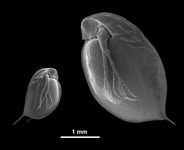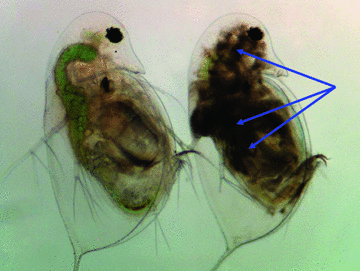Multiple stressors in ecosystems
The influence of multiple stressors on communities, food webs and ecosystem functions is an important research area of the Department of Animal Ecology. The effects of biotic stressors, such as predators and parasites, and also of anthropogenic stressors, such as so-called "micropollutants", are tested. The effects of simultaneous stressors are investigated using host-parasite and predator-prey interactions as examples. A fundamental understanding of the impact of multiple stressors on organisms and communities plays an essential role in biodiversity research. In the interdisciplinary studies, current molecular biological methods, classical experimental approaches in laboratory and field studies, as well as modern imaging microscopic techniques are used.
Ongoing projects
EcoGlob - Ecosystems under Global Change
in cooperation with the JMU Würzburg

Funded by:
- Bavarian State Ministry for Science and Art
- Excellence Networks and University Cooperation (EVUK) funding program (2021)
The joint project "Impacts of global change on biodiversity and ecosystem functions" addresses one of the most urgent research questions worldwide at present.
The applicants are the Julius Maximilian University of Würzburg and the University of Bayreuth. The spokesperson at JMU is Professor Ingolf Steffan-Dewenter, Chair of Animal Ecology and Tropical Biology. At the University of Bayreuth, the spokesperson is Professor Christian Laforsch, Animal Ecology I.
According to the researchers involved, the complex changes in the environment caused by climate change, land use, pollutants and resource consumption urgently require a multidisciplinary approach that takes into account a wide range of aspects in order to gain a better understanding of the long-term effects on biodiversity, ecosystem functions and geochemical material cycles. Understanding these processes is the prerequisite for developing forward-looking and sustainable solutions to this global environmental problem. The participants want to create the scientific basis for this.
- Information on the Hightech Agenda Bavaria and the Hightech Agenda Plus
- Information on the Excellence Strategy
BayÖkotox - Ecotoxicological effects of particulate matter from engine combustion processes on insects.

In our modern industrial society, more and more substances and particles are being introduced into the environment through our actions and economic activities, leaving behind visible and less visible traces. Under certain conditions, substances can influence the balance of ecosystems and destabilise them in the long term. In addition, some substances remain in the environment over the long term. The impact of many anthropogenic substances on ecosystems is still unclear.
On behalf of the Bavarian State Ministry for the Environment and Consumer Protection, the Bavarian State Office for the Environment has conceived the project network "BayÖkotox - Ecotoxicological Assessment of Substances in the Environment". The aim is to develop promising strategies for the ecotoxicological assessment of substances, substance mixtures and substance inputs into the environment. The special form of collaborative research makes it possible to network individual projects with each other. This promotes mutual exchange between the research groups and enables synergy effects. The existing expertise in the field of ecotoxicology is very dispersed in the Bavarian university landscape and has decreased considerably in recent years. The aim of the network is therefore to sustainably link ecotoxicological research activities with each other in order to secure and strengthen know-how and competences in this field in the long term.

Subproject 4 - Influence of particulate matter on insects
Sub-project 4 at the University of Bayreuth is being led by Prof. Heike Feldhaar (Animal Population Ecology) and Prof. Christian Laforsch (Chair of Animal Ecology I) and Prof. Dr. Dieter Brüggemann (Chair of Thermodynamics and Transport Processes).
Fine dust particles resulting from engine combustion processes are being investigated. In addition, the effect of brake abrasion on insects is being investigated in cooperation with subproject 5. Due to the physicochemical properties of fine dust particles, negative effects on insects and their organisms can occur. The aim is to clarify whether these can play a relevant role in the decline of insects. The project should contribute to a better understanding of the potential negative effects of airborne pollutants from traffic and provide impulses for the further development of technical solutions by establishing the terrestrial bumblebee as a bioindicator.
The subproject is being worked on by the doctoral students Frederic Hueftlein and Dimitri Seidenath.
More informationen:
- Website of the subproject 4 - Influence of fine dust on insects
- Project profile subproject 4 - PDF
- Poster subproject 4 - PDF

Funded by:
Bavarian State Ministry for the Environment and Consumer Protection
(2020 - 2023)
Completed projects
Topping up request: Behavioural adaptibility of Daphnia and predator-prey-interactions
Funded by: BMWI (2015)
How to live in a mosaic stressors an ecological genomics approach on the water flea Daphnia EUROCORES-EuroEEFG-Zoology (PAK 516)

STRESSFLEA will develop and use genomics tools to unravel patterns and mechanisms of adaptation to anthropogenic and natural stressors in natural populations, using the water flea Daphnia magna as a model system. Daphnia is a key model organism in ecology, evolutionary biology and ecotoxicology, and rapidly develops to become a leading model invertebrate in ecological genomics. Daphnia has clear assets as an ecogenomic model because of its ecological importance and life cycle features (short generation time, clonal lineages, layered dormant egg banks). STRESSFLEA aims to (1) obtain insight into the genomic underpinning of genetic adaptation to specific stressors (predation, parasitism, habitat unpredictability, metal pollution); (2) identify gene function by linking gene expression to trait values; (3) obtain insight into the genomics of adaptation to multiple stressors; and (4) reconstruct evolutionary processes over an extended time axis through the use of genomic markers and candidate genes in layered egg banks. STRESSFLEA brings together the key European research groups developing genomic resources for studying responses to stressors in natural Daphnia populations (supplemented with a pivotal research group from the US), and combines transcriptome analysis, targeted genome scans, QTL analysis and gene mapping, microarrays, proteomics and methylome analysis to identify candidate loci and associated SNP markers, analyse gene function, and apply this knowledge to reconstruct evolutionary dynamics in a paleogenomics approach and analyse the dynamics and signature of local adaptation. The legacy of STRESSFLEA will include firm insight into the genomic underpinning of local adaptation to single and multiple stressors, insight into the dynamics of micro-evolutionary adaptation over extended timescales, a strongly elaborated genomics and transcriptomics toolbox for ecologic genomics using the model system Daphnia, and a firmly established network of European research groups that collaborate on ecological and functional genomics of natural populations, using Daphnia as a model.
Funded by:
- German Research Foundation (DFG) 2010 - 2014 - Project number 166183299
- Sumoen Akatemia (AKA), Finland
- Grantová agentura Ceské republiky (GACR), Czech Republic
- Swiss National Fund (SNF), Switzerland
- European Science Foundation, EuroEEFG
Facing multiple enemies: trade-offs between adaptive responses to predators and parasites in the context of inducible defenses.

Image of uninfected (left side) and heavily infected Daphnia hosts (from the D. longispina complex). These animals were kept in the control media. The arrows indicate regions of high spore density.
In nature, organisms encounter a variety of enemies simultaneously, leading to trade-offs between adaptive responses. In predator-prey interactions, for example, a defence trait against one predator could render the prey more vulnerable to another predator. Hence, phenotypic plasticity in the prey’s defensive traits is a widespread mechanism to cope with a continuously changing predator spectrum. The costs and benefits of these inducible defences have not been explored in the context of simultaneous exposure to enemies from different functional levels, such as predators and parasites. In the here summarized research project we studied the effects of such a multiple-enemy situation. Specifically, we addressed trade-offs between prey morphological, life-history and behavioural responses to predator threats and their susceptibility to common and virulent parasites. Our target prey and host animals were waterfleas (Daphnia), which are a well-established model system in both predator-prey and host-parasite research, and thus allowed us to build on earlier developed tools and methods.We performed several laboratory experiments, in order to advance our understanding of adaptive plasticity and community dynamics in a multiple enemy context.
Here we list the most important finds:
- Daphnia induced defended morphs were significantly more vulnerable to infection by a virulent yeast parasite than undefended morphs (system: D. longispina – fish – Metschnikowia). Thus, we demonstrated a previously unknown and environmentally relevant cost to inducible defenses.
- Some of the Daphnia responses to parasites were altered or even reversed by the presence of predator cues (system: D. longicephala – back swimmer – Metschnikowia). For example, time to maturity was further delayed when the Daphnia were exposed to both threats than under parasite stress alone. These results imply that the impact of parasites on host species depends strongly on the presence of further threats.
- The parasite suppressed inducible defences expressed towards one predator (system: D. magna – tadpole shrimp – Metschnikowia), but not those expressed towards another predator (system: D. magna – fish – Metschnikowia). Our study suggests that as specific inducible defences differ in their costs, some might be suppressed if a target prey is additionally infected.
- Parasite shows higher virulence at Daphnia infected at young age (system: D. magna – Metschnikowia). Thus, using experimental protocols with non-standardized time of infections might cause difficulties in comparison of the results and, eventually, can even underestimate the impact of parasites, as infection at an early lifetime may lead to more reduced fitness.
- There was no maternal effect on offspring resistance, life histories or morphologies (system: D. magna – Metschnikowia), which is in contrast to a previous study conducted on another parasite species. We anticipate that the transfer of maternal effects in Daphnia hosts is parasite specific. Overall, this project enhances our understanding of adative phenotypic plasticity and its evolution. In addition, we show that one has to take into account many additional parameters (like age of infection or maternal effects) to better estimate the role of host-parasite (and predator-prey) interactions in aquatic systems.
Funded by:
German Research Foundation 2010 - 2014 - Project number 165935089
Publications (selection)
- Engelbrecht, W.; Hesse, O.; Wolinska, J.; Laforsch, C. (2013)
Two threats at once : encounters with predator cues alter host life-history and morphological responses to parasite spores. Hydrobiologia. https://doi.org/10.1007/s10750-012-1396-2. - Hesse, O., Engelbrecht, W., Laforsch, C., Wolinska, J. (2012)
Fighting parasites and predators: How to deal with multiple threats?
BMC Ecology https://doi.org/10.1186/1472-6785-12-12 - Yin, M., Laforsch, C., Lohr, J. N., Wolinska, J. (2011)
Predator-induced defense makes Daphnia more vulnerable to parasites.
Evolution https://doi.org/10.1111/j.1558-5646.2011.01240.x
